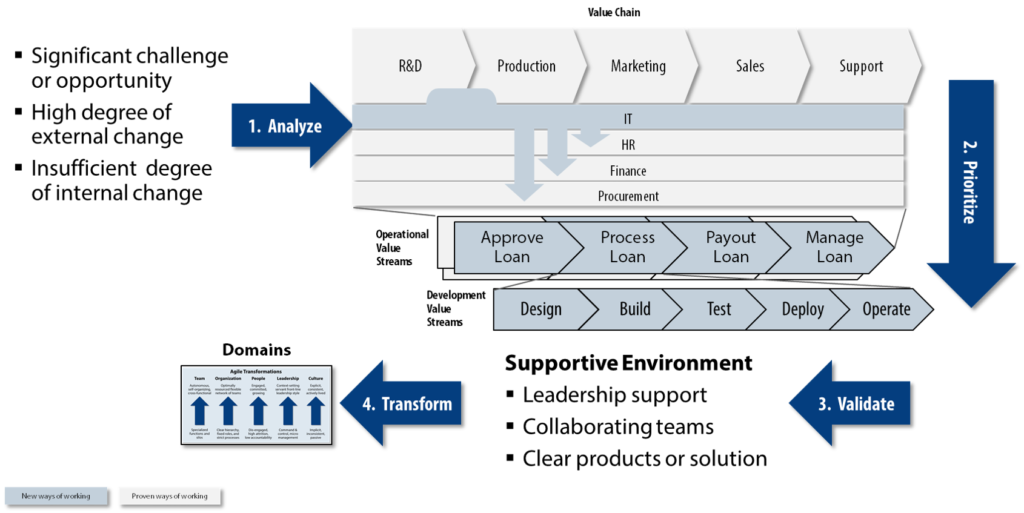Scope answers the “Where?” question of an agile transformation. The My Business Agility Framework helps you to identify where to start with an agile transformation and uses an agile approach that allows the scope to broaden and change over time.
Agile excels under conditions of uncertainty and complexity and where innovation and flexibility are required. Not all business activities have those properties. So not every department, function or team will benefit from agile ways of working in the same way.
Especially at the beginning of an agile transformation it is important to pick the right place to start for two reasons. Firstly, the move to agile is often urgent and you want to have the biggest possible impact by starting there where it is needed most. Secondly, you want to choose a place that puts you on a winning track.
The importance in agile is to get started. You will learn and adapt as you go along.
The scoping guidance provided by My Business Agility helps you to find the best place to start an agile transformation.
So where are those ‘best’ places?
At the beginning of an agile transformation you want to pick the right place to start to increase your chances of success.
Every new initiative needs to prove itself to the organization. Starting with a strong case, generating early wins and demonstrating clear benefits are equally important for an agile transformation to receive strong and ongoing support from the organization.
The criteria you should consider when selecting your place to start an agile transformation include hard and soft factors:
Hard Factors:
- High degree of external change
- Insufficient internal rate of change
- Significant challenge or opportunity
- Clear product or solution
Soft Factors:
- Leadership support
- Motivated people
- Collaborating team
Hard Factors
Agile is about speed and flexibility to respond to external change. It is the places in your business that are exposed to rapid external change that require agility most. If you are not agile enough to cope with it, this is the place to start.
Equally important is that your starting point can prove the benefits of agile. Having a clear product or solution that you can develop ensures that you will be able to articulate the benefits better. It makes the achievements tangible and demonstrable.
Having a significant challenge or opportunity increases the benefits. But beware that you don’t want to pick something too big as this often equates to a higher risk of failure or something that takes too long as you will delay the success. You want something that proves quickly that agile really works.
Once you are clear that the actual topic you want to apply agile to is suitable you need to validate that its immediate organizational environment is conductive to success. Here soft factors play an important role.
Soft Factors
The support, buy-in, active leadership, and participation of the executives overseeing your agile transformation is critical. Agile ways of working are drastically different to traditional ways of working and will encounter road blocks that might require an executive ‘nudge’ to overcome. Resistance and frustration benefit from a credible re-confirmation that this is important and urgent.
Ideally, you find an existing team that is eager, motivated and committed to adopt agile.
Agile teams are cross-functional and you may have to broaden the existing team by bringing in people that may not have worked together before. Having people on your team who have worked agile before, maybe in a previous job, is also helpful.
Getting your new team to collaborate may not be a given out-of-the-box. Be prepared to invest in team building activities but focus on getting the team to work together quickly. Nothings forms teams better than working towards a common objective.
Invest in a strong Scrum Master and assign her/him full-time until the team runs smoothly. This will take a few iterations.
Analytical Approach
As an alternative to the more informal approach described until here My Business Agility also supports a structured, analytical approach using a value chain and stream analysis.

In the case of complex businesses this may be the better approach to identify these places that cause, for example, the greatest delays.
Contact us if you would like to find out more.
